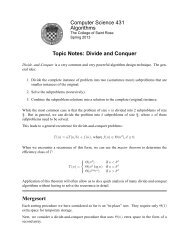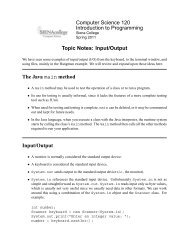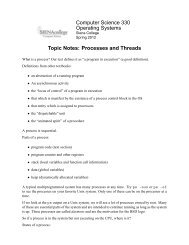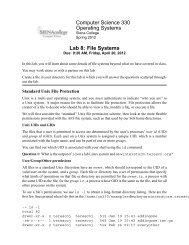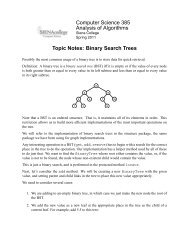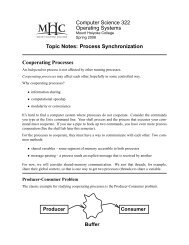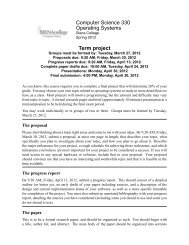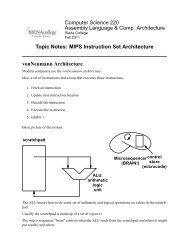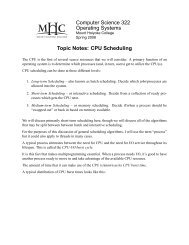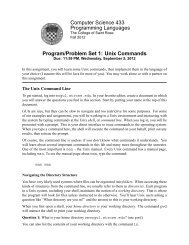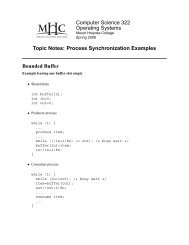Topic Notes: MIPS Programming - Courses
Topic Notes: MIPS Programming - Courses
Topic Notes: MIPS Programming - Courses
You also want an ePaper? Increase the reach of your titles
YUMPU automatically turns print PDFs into web optimized ePapers that Google loves.
Computer Science 220Assembly Language & Comp. ArchitectureSiena CollegeFall 2011<strong>Topic</strong> <strong>Notes</strong>: <strong>MIPS</strong> <strong>Programming</strong>We spent some time looking at the <strong>MIPS</strong> Instruction Set Architecture. We will look at the ISA itselfmore carefully when we consider its implementation. But next, we will learn how to program in<strong>MIPS</strong> assembly language.Our arsenal of <strong>MIPS</strong> assembly instructions now includes:• add $a, $b, $c• sub $a, $b, $c• addi $a, $b, n• lw $a, n($b)• sw $a, n($b)• sll $a, $b, n• srl $a, $b, n• lui $a, n• and $a, $b, $c• andi $a, $b, n• or $a, $b, $c• ori $a, $b, n• nor $a, $b, $c• beq $a, $b, L• bne $a, $b, L• slt $a, $b, $c• j LControl Structures in <strong>MIPS</strong> AssemblySuppose we want to implement a while loop in <strong>MIPS</strong> assembly. Consider the high-level languagecode:while (a!=b)a += i;where a is stored in register $s0, b in $s1 and the increment i is in $s2.Our <strong>MIPS</strong> assembly code might look like this:Loop: beq $s0, $s1, EndLoop # if a==b goto EndLoopadd $s0, $s0, $s2 # a = a + ij Loop # goto LoopEndLoop:... code after loop ...
CS 220 Assembly Language & Computer Architecture Fall 2011Note that we use a beq instruction here as we want to branch in the case where we no longer wishto execute the contents of the loop.Now consider a slightly more complicated loop:while (a[i] == k)i += j;We need to deal with an array access here. Suppose we have made the following register assignments:The start of array a is in $s3, i is in $s0, k is in $s1, and j is in $s2. All are int values.One way to implement this code would be:LoopTop: sll $t0, $s0, 2 # t0 = i * 4add $t0, $t0, $s3 # t0 = address of a[i]lw $t1, 0($t0) # t1 = contents of a[i]bne $t1, $s1, EndLoop # if a[i] != k, goto EndLoopadd $s0, $s0, $s2 # i = i + jj LoopTop # jump back to the top of the loopEndLoop:... code after loop ...A few notes:• We need to multiply i by 4 to get the correct offset, since we’re assuming a is an array ofword-sized values.• We might be tempted to writelw$t1, $t0($s3)to access the value at an offset of $t0 from our base register $s3. But that is not valid<strong>MIPS</strong> - the offset part of the lw and sw instructions needs to be a constant, not a register.The <strong>MIPS</strong> designers could have provided such an instruction (it would be R-format insteadof I-format), but they chose not to.Before we can complete our next example, we need a couple of additional instructions – readingand writing single bytes from memory.These instructions, lb for load byte and sb for store byte, work just like the lw and sw instructionsexcept that only single-byte values are processed.lb$a, n($b)2
CS 220 Assembly Language & Computer Architecture Fall 2011Loads the single byte at an offset of n from register $b and stores it, sign-extended, into register$a.sb$a, n($b)Stores the byte in the bottom 8 bits of register $a into memory at an offset of n from register $b.String Processing ExamplesArmed with these instructions, we can write our next example: a string copy function like C’sstrcpy:strcpy(dest, src);Recall that C strings are terminated with a null (0) character.For now, we’ll just look at the main loop of this function. Assume register $s1 holds the addressof the start of the dest string and that $s2 holds the address of the start of the src string.Our task is to write a loop that copies characters (bytes) from the source string to the destinationstring.LoopTop: lb $t0, 0($s2) # temp reg = char at $s2sb $t0, 0($s1) # char at $s1 gets temp regaddi $s2, $s2, 1 # increment $s2addi $s1, $s1, 1 # increment $s1bne $t0, $zero, LoopTop # branch if we didn’t just copy a nullFor another example:char a[11];... put something in a ...for (i=0; i
CS 220 Assembly Language & Computer Architecture Fall 2011LoopEnd:lb $t3, 0($t2) # t3 gets a[i]sb $t3, 1($t2) # a[i+1] gets t3addi $s0, $s0, 1 # i++j ForLoop # back to check loop condition<strong>MIPS</strong> Subroutines and ProgramsYou are all familiar with function/method calls in high-level languages. In assembly language, weusually refer to these as subroutines.The idea is the same as a function or method call – the program branches from its sequence ofinstructions to execute a chunk of code elsewhere, then returns to continue where it left off.Moreover, we expect that the values (the actual parameters) we pass to the subroutine are properlypassed to the corresponding formal parameters in the subroutine. We expect that appopriatespace is allocated for the subroutine’s local variables. And any return value from the subroutine isreturned to the caller, with the opportunity to store or use it.As assembly language programmers, we need to manage all of that complexity.We’ll now look at how to write and call subroutines in <strong>MIPS</strong> assembly.Special Registers and InstructionsRecall that there are several registers reserved to help support subroutine calls:• $a0-$a4: argument registers – a place for the caller to place values to send to the subroutine.• $v0, $v1: return value registers – a place for subroutines to return values to the caller.• $ra: return address register – where to resume executing the caller when the subroutine isfinished.We also have a couple of special jump instructions:• Jump and Link:jal addressThis instruction puts the address of the next instruction (PC+4) into register $ra, then jumpsto the address.This is a J-format instruction, just like the standard jump instruction (j).• Jump to Register:4
CS 220 Assembly Language & Computer Architecture Fall 2011jr $aJumps to the address specified in the given register.This is an R-format instruction.Assuming the subroutine hasn’t changed the $ra register, this can be used to return fromthe subroutine.Registers and the StackWe said previously that the “s” registers $s0-$s7 are the ones assigned to variables and the “t”registers $t0-$t9 are temporary values.This becomes important when we start looking at subroutines. The accepted convention for registeruse by subroutines:• $t0-$t9 are always available for use by a subroutine– if a subroutine calls another subroutine, it must assume that the called subroutine willmodify $t0-$t9.– if this is a problem for the calling subroutine, it should save any values it has in $t0-$t9 to memory and restore them after the subroutine call.• $s0-$s7 should be unchanged by a subroutine call– if a subroutine calls another subroutine, it can expect its values in $s0-$s7 to remainupon return.– if the called subroutine wishes to make use of $s0-$s7, it should save the caller’svalues in any of these registers it will use in memory, then restore them before return.Since subroutines can be called by anyone, we don’t know which “s” registers, if any, are importantto the caller. So we have to save these if we use them.So where do we save values in memory when we need to save them? On the stack.The stack is a section of memory dedicated to saving registers to manage subroutine calls.We have a special register $sp called the stack pointer that indicates the top of the stack.The stack grows and shrinks as registers are saved and restored during a program’s execution.If we have a subroutine that will need to make use of $s0, $s1 and $s2, we need to do thefollowing at the start of the subroutine’s code:addi $sp, $sp, -12 # make room for 3 4-byte valuessw $s0, 0($sp) # push s0sw $s1, 4($sp) # push s1sw $s2, 8($sp) # push s25
CS 220 Assembly Language & Computer Architecture Fall 2011Then before returning:lw $s2, 8($sp) # pop s2lw $s1, 4($sp) # pop s1lw $s0, 0($sp) # pop s0addi $sp, $sp, 12 # restore the stack pointerNote that we “pop” in the opposite order as we “push”.A First Complete SubroutineLet’s return to our string copy code:LoopTop: lb $t0, 0($s2) # temp reg = char at $s2sb $t0, 0($s1) # char at $s1 gets temp regaddi $s2, $s2, 1 # increment $s2addi $s1, $s1, 1 # increment $s1bne $t0, $zero, LoopTop # branch if we didn’t just copy a nullIn order to make this a subroutine, we need to get values from the subroutine argument registersand save and restore values of any “s” registers we decide to use. Our code becomes:strcpy: addi $sp, $sp, -8 # make space for 2 words on the stacksw $s2, 4($sp) # save s2sw $s1, 0($sp) # save s1add $s1, $a0, $zero # copy arg0 into s1add $s2, $a1, $zero # copy arg1 into s2LoopTop: lb $t0, 0($s2) # temp reg = char at $s2sb $t0, 0($s1) # char at $s1 gets temp regaddi $s2, $s2, 1 # increment $s2addi $s1, $s1, 1 # increment $s1bne $t0, $zero, LoopTop # branch if we didn’t just copy a nulllw $s1, 0($sp) # restore s1lw $s2, 4($sp) # restore s2addi $sp, $sp, 8 # restore spjr $ra # return from subroutineNote that we could so something simpler here: save and restore $a0 and $a1 and use those inplace of $s1 and $s2 throughout.A Recursive ExampleWe will develop a <strong>MIPS</strong> assembly subroutine to implement the following C function:6
CS 220 Assembly Language & Computer Architecture Fall 2011int factorial (int x) {if (x= 1, just return 1addi $v0, $zero, 1 # return value is 1# we could restore $a0 and $ra but we know they haven’t# changed when we take this quick exit, so let’s not# but we still need to put $sp back the way we found itaddi $sp, $sp, 8jr $ra # return to caller# here, x>=1 so we need to make a recursive callL1: addi $a0, $a0, -1 # get x-1 for the parameterjal factorial # recursive call, will put answer in $v0# We now want to set up for the multiply, but we destroyed $a0# above, but have it on the stack, so let’s load itlw $a0, 4($sp)add $a1, $v0, $zero # put factorial(x-1) result into $a1jal multiply # multiply $a0*$a1, put result in $v0# $v0 is where we want our answer, so no work there# but multiply could have changed $a0 and did change $ralw $ra, 0($sp) # restore $ra7
CS 220 Assembly Language & Computer Architecture Fall 2011lw $a0, 4($sp) # restore $a0addi $sp, $sp, 8 # restore $spjr $ra # return to callerTrace through this with the call factorial(3).Another example: arraycmpAdvanced Stack Management<strong>MIPS</strong> makes life easy for many subroutines: if the parameters can be passed in the a registers, thereturn value provided in the v registers, and all local variables can be stored in s and t registers,little management of the call stack is needed.Yes, we need to save registers when we need to use some s registers or make a subroutine call.But with other ISAs and with more complex subroutines even in <strong>MIPS</strong>, there is more to it.For more than 4 parameters, or for parameters that do not fit in a 32-bit register:• the caller is responsible for pushing those parameters onto the stack before calling the subroutine,• the subroutine (the “callee”) will find those parameters in the proper location on the stack,and• the caller will pop the parameters from the stack upon return.If we have more local variables than fit in registers, or if some of our local variables are structures orarrays, space may also be allocated on the stack to hold these values. The subroutine is responsiblefor management of the stack to make space for these local variables and to restore the stack to itsoriginal state when finished.The section of the stack used for a procedures parameters, local variables, and saved registers iscalled the procedure frame, or call frame or activation record of the procedure.8




